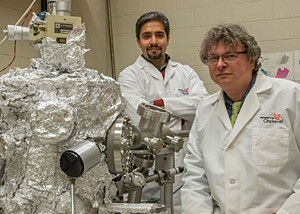
UC Researchers Tackle the Tiniest Technology to Make Gadgets Smaller, Faster and More Efficient
University of Cincinnati researchers are discovering how to manipulate light to one day better view the worlds tiniest objects through a super-lens, as well as how to hide an object in plain sight.
Masoud Kaveh-Baghbadorani, a doctoral student in the University of Cincinnatis physics program, will present this research on March 4, at the American Physical Society Meeting in Denver.
The research focuses on exciting collective oscillations of metal electrons called plasmons, and on directing light through nanometer-thin metal films, about a thousand times thinner than a human hair. The result could empower integrated circuits or facilitate a super-lens with seven times the strength of a standard microscope, opening further research into fields such as studying microorganisms and viruses.
Other applications involve bouncing light around an object by cloaking it with a metamaterial film. Instead of the object reflecting light and thus causing it to be seen, the light manipulation can make it invisible.

lab
Plasmonics is an emerging field, but it has its limitations due to the loss of energy in the metal layers, which dissipate the plasmon energy into heat. Kaveh-Baghbadoranis research focuses on developing hybrid metal/organic nanowires that essentially work as an energy pump to compensate for metal losses in plasmonic nanostructures.
This energy pump results from exciton radiation, an electronic excitement in the semiconductor nanowires. Kaveh-Baghbadorani explains that the exciton functions somewhat like a hydrogen atom negative and positive charges are bound together. The research is examining energy transfer from excitons in semiconductor nanowires to different metal materials used to cover the nanowires, as well as the effects of the thickness of covering organic layers in energy transfer.
The researchers want to know how the dynamics of excitons are affected by the use of different organic materials, and how lifetime and energy transferring processes of nanowire excitons are modified by changing the design of the nanowires or the thickness of organic spacer layers.
Kaveh-Baghbadoranis advisor, Hans-Peter Wagner, a UC associate professor of physics, is one of the co-researchers on the project. To achieve our goal, the knowledge of exciton relaxation and energy-transfer processes in plasmonic semiconductor nanowire heterostructures is of crucial importance, says Wagner, whose lab has a growth facility to allow researchers to produce a variety of plasmonic structures. The lab also has special optical methods to measure exciton relaxation processes on a sub-picosecond time-scale.

Masoud Kaveh-Baghbadorani
Co-researchers on the project include Wagner; Qiang Gao, research fellow, and Chennupati Jagadish, professor of engineering, Australian National University, where the semiconductor nanowires are produced; and Gerd Duscher, professor of engineering, University of Tennessee.
The
American Physical Society meeting
is the largest meeting of its kind in the world, and focuses on research from industry, universities and major labs. The meeting brings together nearly 10,000 physicists and students to share their groundbreaking research.
The University of Cincinnati was the first institution west of the Appalachian Mountains to offer a PhD in Physics.
Related Stories
Exploring careers in robotics engineering: A path to the future
March 28, 2025
Discover robotics engineering careers: skills, paths, and opportunities in manufacturing, healthcare, and space. Explore salaries and how to start at UC’s CEAS.
DAAP Graduate Programs introduces a new entrepreneurial pathway
March 25, 2025
Graduate students in art and design, at the College of Design, Architecture, Art, and Planning (DAAP), have a new opportunity to earn a certificate in entrepreneurial studies through the Lindner College of Business.
President Pinto shares search update for executive vice...
March 25, 2025
President Neville Pinto shares search update for executive vice president for academic affairs and provost
